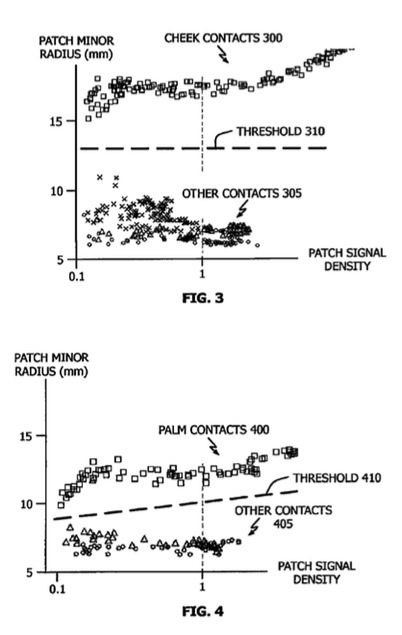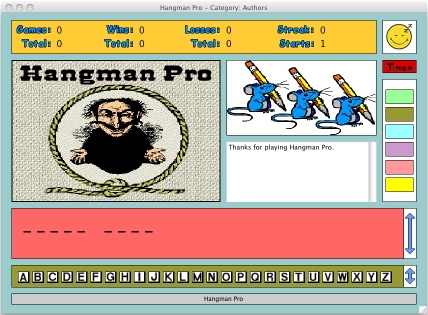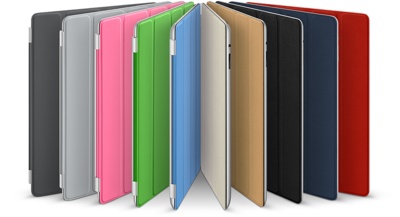An Apple patent (number 8243041) for multi-touch input discrimination has appeared at the U.S. Patent & Trademark Office. It relates generally to data input methods and devices for electronic equipment and, more particularly, to methods and devices for discriminating between various inputs to a multi-touch touch-surface input device.
Techniques for identifying and discriminating between different types of contacts to a multi-touch touch-screen device are described. Illustrative contact types include fingertips, thumbs, palms and cheeks. By way of example, thumb contacts may be distinguished from fingertip contacts using a patch eccentricity parameter. In addition, by non-linearly deemphasizing pixels in a touch-surface image, a reliable means of distinguishing between large objects (e.g., palms) from smaller objects (e.g., fingertips, thumbs and a stylus) is described.
Here’s Apple’s background and summary of the invention: “There currently exist many types of input devices for performing operations with an electronic system. These operations often correspond to moving a cursor and/or making selections on a display screen. Illustrative electronic systems include tablet, notebook, desktop and server computer systems, personal digital assistants, audio and video control systems, portable music and video players and mobile and satellite telephones. The use of touch pad and touch screen systems (collectively ‘touch-surfaces’) has become increasingly popular in these types of electronic systems because of their ease of use and versatility of operation.
“One particular type of touch-surface is the touch screen. Touch screens typically include a touch panel, a controller and a software driver. The touch panel is characteristically an optically clear panel with a touch sensitive surface that is positioned in front of a display screen so that the touch sensitive surface is coextensive with a specified portion of the display screen’s viewable area (most often, the entire display area). The touch panel registers touch events and sends signals indicative of these events to the controller. The controller processes these signals and sends the resulting data to the software driver. The software driver, in turn, translates the resulting data into events recognizable by the electronic system (e.g., finger movements and selections).
“Unlike earlier input devices, touch-surfaces now becoming available are capable of simultaneously detecting multiple objects as they approach and/or contact the touch-surface, and detecting object shapes in much more detail. To take advantage of this capability, it is necessary to measure, identify and distinguish between the many kinds of objects that may approach or contact such touch-surfaces simultaneously. Prior art touch-surface systems (including their supporting software and/or circuitry) do not provide a robust ability to do this.
“Thus, it would be beneficial to provide methods and devices that identify and discriminate multiple simultaneous hover or touch events such as, for example, two or more closely grouped fingers, palm heels from one or more fingers, fingers from thumbs, and fingers from ears and cheeks.
“In one embodiment the invention provides a method to discriminate input sources to a touch-surface device. One method includes obtaining a proximity image, segmenting the image into a plurality of patches, determining an eccentricity value for each patch, identifying those patches have an eccentricity value greater than a first threshold as a thumb contact. This method may also be used to identify fingertip contacts (i.e., those patches having an eccentricity value less than the first threshold).
Another method includes obtaining a proximity image, segmenting the image to identify a plurality of patches (each patch having one or more pixels and each pixel having a value), reducing the value of each pixel in a non-linear fashion, determining a minor radius value for each patch, identifying those patches having a minor radius value greater than a specified radius as a palm contacts, and using the identified patch to control an operation of a touch-surface device.
“In another embodiment, the first and second methods may be combined. Thresholds may comprise constant values, linear functions or non-linear functions. Illustrative operations of a touch-surface device include, but are not limited to, rejecting spurious input and changing the operating mode of the touch-surface device. Illustrative modes changes include, but are not limited to, dimming the device’s backlight, putting the device to sleep, waking the device from a low-power state, putting the device into a low power state (e.g., off or ‘sleep’) and, for mobile telephones, answering calls and terminating calls. One of ordinary skill in the art will recognize that the methods described herein may be organized as one or more program modules, stored in a tangible form (e.g., a magnetic disk), and executed by a programmable control device (e.g., a computer processor).”
Wayne Westerman is the inventor.
Apple has also been granted a patent (number 8,243,018) for a mouse with multi button functionality is disclosed. The mouse includes a housing that surrounds the internal components of the mouse. The housing includes at least a first member and a second member, each of which forms a substantial portion of the housing.
The first member moves relative to the second member so as to implement at least one of the multiple button functions of the mouse. The inventors are Abraham Farag and Brian Q. Huppi.





